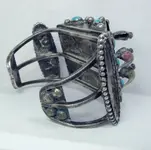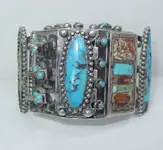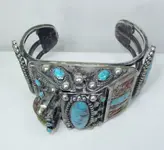I'm not seeing Native American or old here. I was in the business for many years and this is much more like a relatively modern inexpensive Tibetan or Indian piece than anything Native American. It's certainly doesn't resemble Navajo work.
The chain work around the Turquoise settings is modern factory made bezel strip but it's sterling (925) - not fine silver (999) like an American made piece would be from the modern era. Factory made bezel wasn't used in pre modern Native American Jewelery.
The claws are from a cat - not a bear as used in later Navajo and 70's hippy turquoise/silver work. Cat claws are very much an Asian indication and tradition. The red tone dye on the claw is also very Asian.
The low temp wire solder work is also a clue. The etching from the lead content of the silver solder isn't seen in America except on very amateur hobby silversmithing. The latch itself is very reminiscent of inexpensive Tibetan jewelry.
The bracelet isn't a cuff form at all. Cuff form Native American bracelets are an ornamental evolutionary form of the
Ketoh - no archer could conceivably use a bracelet of this design.
The bracelet is composed of several different pieces. It was not "designed" in this form. The rough filework to create the loose fit of the lid of the compartment is a good indication as well as the attachment of the roughly modified flatwork mounts on the ends of the compartment. The cat claws were clearly cut from another piece and soldered over the top of the three mismatched Turquoise side mounts.
Jewelry that is assembled from many other pieces is very common in inexpensive Tibetan and Indian jewelry, it's virtually unknown in American native designed jewelry with the exception of fine
Zuni petit point jewelry work - this piece doesn't resemble Zuni jewelry in any respect.
Hallmarks were used fairly early in Native American silversmithing. I think the first use was by Bae-ie-schluch-aichin of the "Slim" family in the 1880's. Hallmarks are found on nearly all serious Navajo jewelry. Lack of a hallmark doesn't mean the piece isn't authentic but it does establish that the maker was probably little known. Known quality makers bring good values at auction. Unknown makers and poor work don't have much marketable value.
Just some points to consider when determining the value and origin of this type of jewelry.











